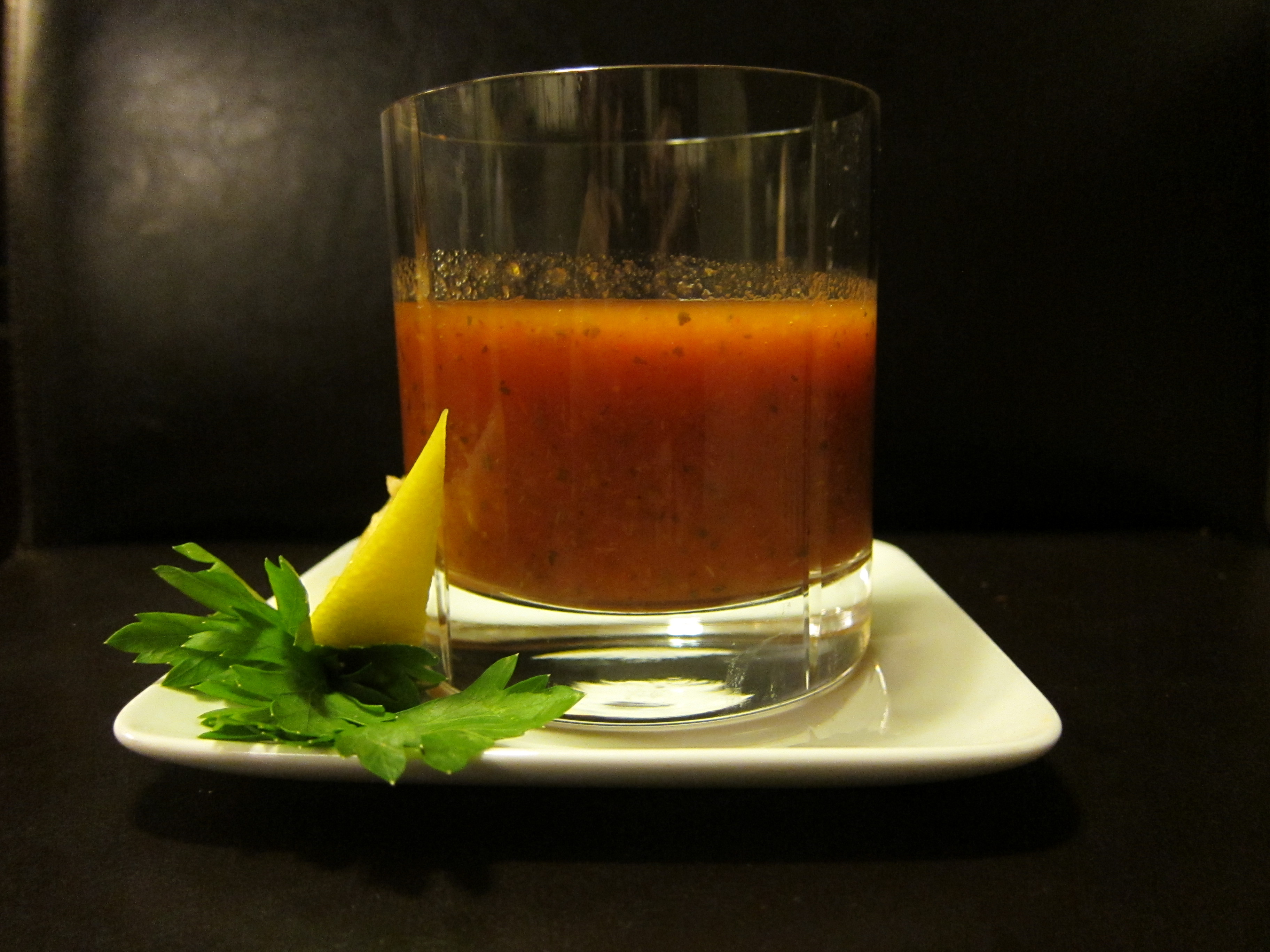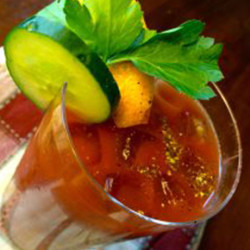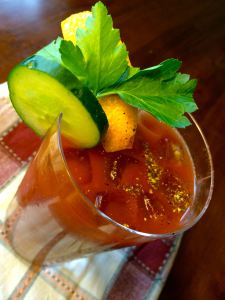Friday, November 4, 2011
I have some unfinished business I need to complete regarding vegetable juices, and this is the subject of today’s post. It’s almost as thrilling as maple buttercream and pan seared bluefish, I know. (Not served together! Geesh.) In all seriousness, though, I was in fact pretty darn excited when I made homemade vegetable juice, so I’m glad to have the opportunity to revisit the issue.
Truth be told, I have no idea how many people actually drink tomato juice and/or whatever other vegetables juices in the year 2011 – and there are quite a few on our crowded supermarket shelves. I imagine it was more popular a few decades back: in an episode of Mad Men c.1960 a woman ordered a tomato juice apéritif, which came served with a lemon wedge. I laughed when the waiter brought the juice over because it looked exactly like the juice I served up on the video I posted a few weeks back. (See picture, right, and you can also click here to watch how I made it.)
Nevertheless, at least one student in my class drinks it – hence this email – and I know some people enjoy bloody or virgin marys with brunch, so in this post I’ve provided some things for you to consider if you include vegetable juices in your diet. (I’ll save the fruit juice discussion for another time, although some of the issues are the same.)
Let’s Get Quantitative
Yes, I do love saying that, and it just may become one of my catch phrases. Reading nutrition information and understanding how things fit together in a healthy diet has a quantitative element to it, and one of my goals is to help you become better acquainted and more comfortable with these numbers. Nutritional literacy, let’s call it, which is really just a subset of scientific literacy. Knowing your numbers is especially important when it comes to watching your weight.
Before you roll your eyes, if you’ve been following my blog, you’ve read enough at this point to understand that it’s not always about numbers and nutrition with me. That would be no way to go through life. See previous buttercream reference, for example, with many more yummy things to come as we approach holiday baking season. So bear with me today, because moderation, indulgence, and nutrition all come together in my world to create delicious and healthful habits that also keep your sweet tooth satisfied.
The Positive: Lots of Veggies, Loads of Nutrients
Most vegetable juices are a mix of lots of different veggies. For example, my recipe included tomatoes, onions, parsley, red and green peppers, and carrots and celery with their fronds. In other words, I’d need to eat all those vegetables to get the array of nutrients I obtained in just one glass of juice. Thus, there is truth in adverts that highlight the number of servings of veggies you get in a juice, which is often 2 or more. It’s not a small point, because the vast majority of people do not consume the recommended amounts of vegetables and fruits per day needed for optimum health. Do look at the ingredients list, however. Many brands are 100% vegetable juice but it will vary by company and many will include other stuff you don’t want or need.
Vegetable juices are a terrific source of many vitamins and minerals, notably vitamins A, C, and potassium; they also provide some fiber and protein (see above table) and smaller amounts of calcium and iron. Potassium is a mineral needed for fluid balance in the body and is important for maintaining normal blood pressure and heart health. And we could all use more fiber in our diet, so important for gastrointestinal health as well as chronic disease prevention. There are also lots of other bioactive components in there, like lycopene (an antioxidant especially prominent in tomatoes), and you get a whole lot more of it in one serving of juice than a single tomato. Lycopene has been associated with decreased risk of prostate cancer and improved eye health, among other health benefits.
Now, I’m not exactly sure how my juice measures up; alas, I don’t have the right instruments in my house to do this. I do know there was no sodium added during preparation, and I conjecture there were levels of vitamins a, c, and potassium at the higher ranges shown in the above table. My tasty concoction was likely higher in fiber than many brands you’d find in the store since I milled it by hand and thus retained a lot of the pulp. (If you’re not into pulp, you could strain it further when making your own though you are removing valuable fiber, much like when removing the bran and germ from the whole grain.)
Always remember that the more broadly you eat across the food supply, especially in the plant kingdom, the more nutrition you get – both the things we know about, and the things we don’t.
The Negative: Excess Sodium and Calories
We all ingest way too much salt, and it’s associated with higher risks of hypertension (high blood pressure), stroke, and heart disease. Remember that canned and processed foods are the biggest culprits, and veggie juice can therefore contribute. If you select an 11.5 oz can of Mr. and Mrs. T’s Spicy Bloody Mary Mix, for example, you’re almost at your daily limit for sodium for optimal heart health (their website for all the ingredients in this particular brand.
As we observed when I examined vegetable stocks a few weeks back, the great thing is that there are low sodium options out there for you to select if you do enjoy vegetable juice and don’t want to make your own. I use store bought vegetable juice when I’m making chili or tomato soup; I can’t imagine I’d make my own all the time, especially in winter. If you do not yet read the Nutrition Facts panel when you shop, I encourage you to begin doing so to get a better handle on what you are putting into your body.
Apart from the sodium issue, it is worth noting the energy (calorie) content of veggie juices, also shown above. Due to their lower sugar content, veggie juices are generally much lower in calories compared to fruit juices and usually do not have added (not naturally occurring) sugars. But they still contain calories, and most of us already take in too many calories, especially from beverages. Plus, we often consume more than what the label tells us is a “serving.” So be aware – or, perhaps, beware – of how much you drink, and do the math as needed; many bottles are approximately 12 ounces, so multiply the above numbers by 1.5.
Importantly, our bodies are not as able to recognize satiety signals from beverages compared to foods, which are what tells our brains that we are full and should stop eating. The fiber in veggie juice helps slow digestion and can help us feel sated, but it’s still a lot easier to ingest extra calories when consuming them in liquid form (juice) compared to solid (whole plants). Of course, if energy intake is not balanced with energy expenditure, weight gain will ensue.
Summing Up: Should’ve Had a V-8?
For a number of reasons, it’s generally better to consume whole foods compared to juices, even if homemade. Literally speaking, it would be better from an energy intake (calorie) perspective to mix all my lovely ingredients together in a salad rather than blend it into a veggie juice, which delivers a concentrated source of calories quickly to the body. The salad would retain all of the same nutrients but I’d get more fiber, digest more slowly, and undoubtedly feel fuller post-prandially (after eating). As a result, I’d likely end up consuming fewer calories. Which is generally a good thing.
But, as I’ve said, it’s awfully hard to make a bloody mary that way, and a cold glass of veggie juice also made a very fine snack one day. As well, it’s quite dense in valuable nutrients, can help meet vegetable and fiber needs, and there are some good choices on the market if you don’t feel like making your own. So, if drinking veggie juice has been a good way to get some extra veggies in your diet and you enjoy it, I’d say go for it. To recap: read the ingredient list, look at the sodium and calorie content, and consume as part of a calorically balanced diet.
You now have about 10 months to get ready for making homemade vegetable juice with me next summer, because I forgot to mention a very important positive, which is taste. Nutrition is one thing, but taste is key, is it not? And, as with so many things, store bought simply does not compare to the fresh and tangy flavors and personal satisfaction you experience from making it on your own.







Hi PK–this post might be a perfect opportunity to show the context of glycemic load to juices, which can get ugly fast. I can’t believe that your low-sodium, mechanically strained (with some fiber intact, obv) v-7 has the same g-load as V-8. But when we need energy how do we factor this number in?
Will Q
PS I’m in the Envr 129 class and love it…
Hi Will,
Thanks for the kind words – so glad you are enjoying the class!!! This is a great question, and actually I will highlight the glycemic index and load issue when I write about fruit juices, when it’s a much bigger deal due to their higher sugar (carb) content. I didn’t highlight it here as veggie juices are fairly low in carbs, thus the impact would not be nearly as bad on your blood glucose (hence blood insulin) as, say, orange juice. And, as you point out, because of the fiber content, you are also helping to ameliorate the glycemic impact. Further, if the juice is consumed with other foods in the context of a meal, the overall glycemic impact would be a affected by that as well. If larger portions are consumed and drunk quickly it starts to be a bigger deal.
Hope this helps!
PKN
PS – I, too, noticed it was a V-7. Next time I’d add a bunch more to make it, say, V-10! Spinach comes to mind…
PK,
Thanks for sharing this. I made a very similar juice the weekend of Irene, as all of the tomoatoes and vegetables were rescued from the garden before the storm came. I used a food mill and felt like I was making bloody marys in Amish country! We used a polish vodka with buffalo grass to make the drinks, and I haven’t had a cocktail I liked that much since. The leftover pulp was delicious – I used it as a spread on little toasties with a little parm on top. Thanks for providing the nutritional information, looks like I will think twice about Mr. Ts from now on…
Kathryn
Sounds very tasty, Kathryn!!! I am jealous you have a garden! Thanks for the comment 🙂
PK